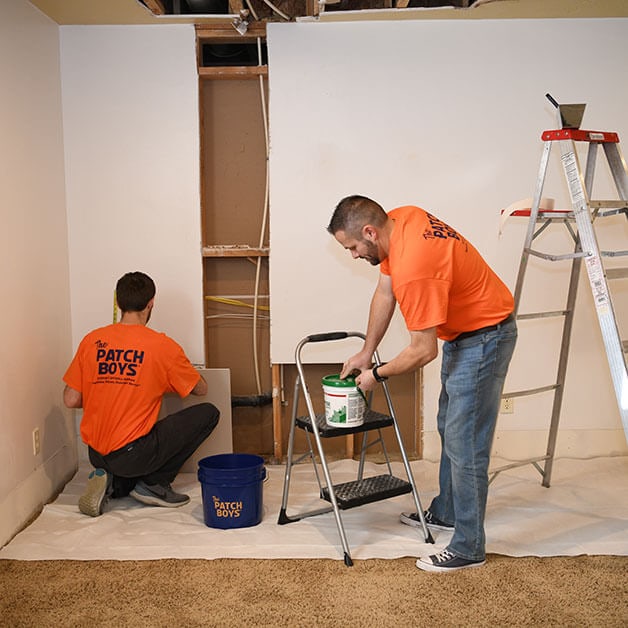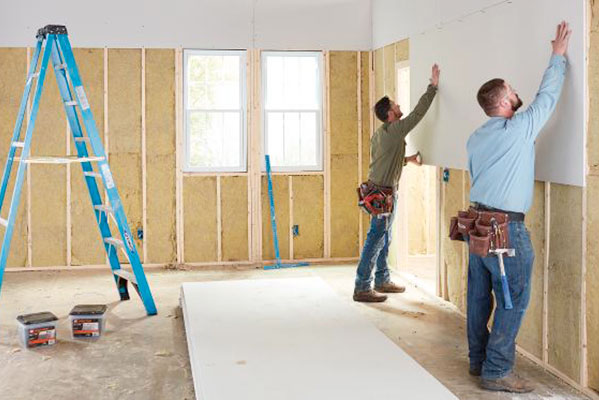Expert Sheetrock Repair Fort Worth for Quick Fixes
Expert Sheetrock Repair Fort Worth for Quick Fixes
Blog Article
Drywall Setup Made Easy: Tips for Perfect Results
Drywall setup is usually viewed as a challenging job, yet with the best method and knowledge, it can come to be a convenient venture. Selecting top quality materials and preparing the setup area are important very first steps that establish the structure for success. Moreover, understanding methods for reducing, hanging, and completing drywall can substantially affect the outcome. As we discover these important tips, you may discover that also the smallest adjustments in your technique can lead to extremely enhanced outcomes, leaving you to think about just how these methods can change your following project.
Selecting the Right Products
Selecting the proper products for drywall installation is critical to achieving a long lasting and cosmetically pleasing finish. drywall repair. The main component, drywall sheets, normally come in numerous thicknesses, with 1/2-inch sheets being conventional for interior walls. For locations calling for additional moisture resistance, such as kitchens or restrooms, take into consideration using eco-friendly board or concrete board, which are specifically made to withstand humidity

Additionally, selecting the right bolts-- either nails or screws-- is crucial for safeguarding the drywall to the framework. Drywall screws are normally preferred for their holding power and decreased risk of popping. Take into consideration the finishing touches such as primer and paint, which not only boost the look but also shield the drywall from moisture and wear.
Preparing the Installation Location
Before beginning the drywall installment process, it is necessary to prepare the setup area extensively. This preparation involves numerous vital steps to make certain a smooth and effective job. Clear the location of any type of furnishings, home appliances, or obstructions that might prevent gain access to. A tidy work area decreases the danger of damages to existing items and permits effective activity during installment.
Following, examine the wall surfaces and ceiling for any kind of imperfections, such as fractures, openings, or mold. Address these problems ahead of time; spot any problems and permit sufficient time for fixings to completely dry. Additionally, make sure that electric outlets, switches, and plumbing are properly placed and made up, as this will certainly impact drywall placement.
Think about the environmental conditions. A steady temperature and humidity level are vital for optimal adhesion and performance of the drywall products. If necessary, make use of a dehumidifier or heating system to develop ideal problems.
Trimming and Hanging Drywall
The key to efficient drywall installment depends on the exact cutting and dangling of the panels. Begin by measuring the space accurately, considering any kind of blockages such as electrical outlets or windows. Make use of a straight side and an utility knife to rack up the drywall along your dimensions, then break it along the racked up line for a clean break. For more detailed cuts, such as around electrical outlets, a drywall saw can be used for precision.

Always function from the top down and left to right, making sure that you maintain a staggered pattern to improve security. Properly hanging the drywall establishes the structure for a smooth finish, eventually bring about exceptional outcomes in your drywall task.
Taping and Mudding Methods
While correct cutting and hanging of drywall sets the stage, the following crucial step entails understanding taping and mudding techniques to make sure a smooth coating. Taping is vital for enhancing joints and preventing cracks; it includes installing tape right into the used joint substance (mud) Beginning with a quality fiberglass or paper tape, applying the tape over the joint and pressing it into the wet mud utilizing a taping blade, making certain no air bubbles continue to be.
Once the tape is in place, apply a thin layer of joint compound over the tape, feathering the edges to create a smooth transition to the drywall surface. Enable this layer linked here to dry totally before sanding it lightly to eliminate flaws. Repeat this process, using added layers of mud as essential-- typically a couple of layers-- while progressively expanding the application location with each layer to attain a smooth appearance.
After the final coat dries, sand the surface with a fine-grit sandpaper until smooth. drywall repair. Keep in mind to wear a mask during fining sand to stay clear of breathing in dust particles. Mastering these taping and mudding techniques is critical for attaining a professional-quality coating in your drywall setup
Completing Touches for Perfection
Attaining a remarkable drywall setup exceeds taping and mudding; it finishes in the completing touches that raise the overall look. These final actions are crucial in making certain a professional-grade surface that boosts the visual appeals of your room.
Begin by sanding the dried joint substance to produce a smooth surface. Make use of a fine-grit sandpaper and a sanding block or post sander for ideal control. Pay particular focus to sides and corners, as these locations tend to call for more meticulous job. After sanding, clean down the walls with a wet cloth to get rid of any dirt bits, making certain a clean surface area for painting.
Next, use a guide specifically created for drywall. This step is vital, as it aids seal the joint substance and gives an uniform base for the overcoat. As soon as the primer dries, check for any flaws, and retouch as required.
Conclusion
Finally, effective drywall installation depends upon the cautious option of materials, extensive prep work of the installment area, and accurate implementation of reducing and hanging strategies. Mastery of taping and mudding procedures is crucial for achieving a smooth surface. Furthermore, interest to ending up touches, consisting of priming and touch-ups, ensures a professional-grade result. By adhering to these guidelines, the high quality of craftsmanship can be substantially boosted, adding to the total aesthetic and capability of the area.
Drywall installation is frequently perceived as a difficult task, yet with the best approach and knowledge, it can come to be a convenient undertaking.Choosing the suitable materials for drywall installation is crucial to attaining a long lasting and visually pleasing surface.Before starting the drywall setup process, it is essential to prepare the installment location completely. Mastering these taping and mudding strategies is crucial for accomplishing a professional-quality coating in your drywall installment.
In final thought, effective drywall installment hinges on the careful option of materials, thorough preparation of the installation area, and precise execution of cutting and hanging strategies.
Report this page